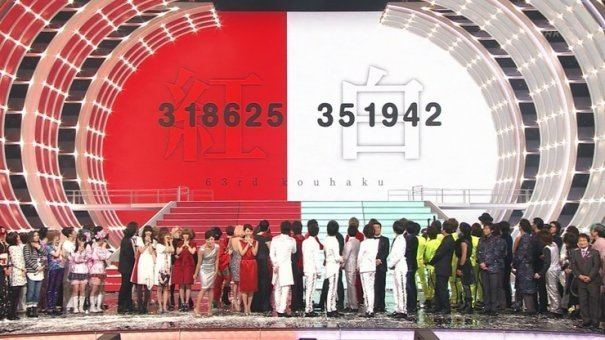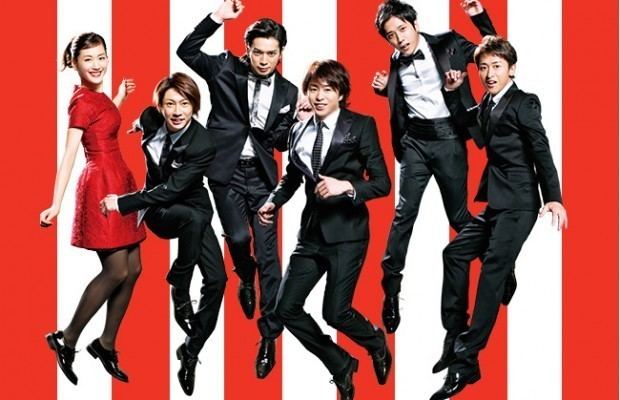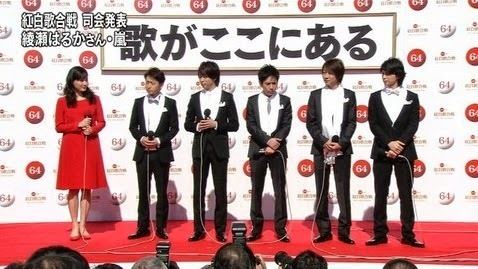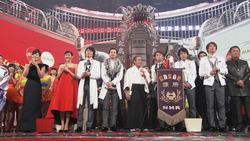Presented by Various (see below) Country of origin Japan No. of episodes 67 contests | Ending theme Hotaru no hikari Original language(s) Japanese First episode date 3 January 1951 Number of episodes 67 | |
 | ||
Genres Music television, Television special Similar Kanjani8 no Janiben, Bōken Japan! Kanjani8 Map, Sex and the City Profiles | ||
Kohaku uta gassen 2016 performers revealed press event smap m i a 24112016
NHK Kōhaku Uta Gassen (NHK紅白歌合戦, Enueichikei Kōhaku Uta Gassen), more commonly known as simply Kōhaku, which official translation is "Year-end Song Festival", is an annual music show on New Year's Eve produced by Japanese public broadcaster NHK and broadcast on television and radio, nationally and internationally by the NHK network and by some overseas (mainly cable) broadcasters who buy the program. The show ends shortly before midnight. Before the show began broadcasting on television in late 1953, the show was held on 3 January and only consisted of a radio broadcast.
Contents
- Kohaku uta gassen 2016 performers revealed press event smap m i a 24112016
- Song selection process
- Show
- Results
- Popularity
- Notable acts in Japanese Entertainment on Khaku
- Pop and rock
- Enka and other contemporary
- Notable foreign competitors on Khaku
- Asian
- Non Asian competitors
- References

Literally "Red and White Song Battle", the program divides the most popular music artists of the year into competing teams of red and white. The "red" team or akagumi (赤組, 紅組) is composed of all female artists (or groups with female vocals), while the "white" team or shirogumi (白組) is all male (or groups with male vocals). The honor of performing on Kōhaku is strictly by invitation, so only the most successful singing acts in the Japanese entertainment industry can perform. In addition to the actual music performances, the costumes, hair-styles, makeup, dancing, and lighting are important. Even today, a performance on Kōhaku is said to be a big highlight in a singer's career because of the show's wide reach.
Song selection process

The songs and performers are examined by a selection committee put together by NHK. The basis for selection are record sales and adaptability to the edition's theme.

At the same time, a demographic survey is conducted regarding the most popular singers for each and what kind of music people want to hear. This and the song selection explain the amalgamation of the musical genres and its artists.

There are, however, exceptions to the process. Momoe Yamaguchi chose to sing her favorite song "Hito Natsu no Keiken" (ひと夏の経験) with its suggestive lyrics during the 25th edition, despite NHK's pick of a different song.
Show

When the show was first broadcast on radio in 1951, each team had a few performers, all of whom would perform within an hour. Since 1989, the program goes on for at least four hours as both teams, each having at least 25 performers, perform their songs.
At the end of the show, the audience and a panel of judges—notable celebrities who may or may not have a connection to the music industry—vote to select the winning team. In the past, the audience vote has been composed of a head count of the venue audience members, who can vote for either team (NHK Hall, which has been the venue for most Kōhaku editions since 1971, can seat 3,000 people). This counted as one vote.
As of the 54th (2003) and 55th editions (2004), viewers who watch the program through ISDB-S on NHK BS Hi-vision could vote by having their own head count in their respective households. Although it is still sketchy to determine in the 55th, the audience vote is counted as two votes: one for the venue audience and one for ISDB-S viewers.
The audience vote(s) are added to those of the judges who each have to vote for one team. The team with the most votes wins.
The above process was done differently for the 56th edition (2005). Instead, the NHK Hall head count, the vote count from cellphone users and the vote count from ISDB-S viewers each counted as one vote. As stated above, the team that got at least two votes won.
In the 57th edition (2006), aside from cellphone and ISDB-S viewers and the NHK Hall audience, 1seg users voted. Its format had been reverted to the ball voting system—from the audience head count and the judges' votes.
From the 58th edition (2007) to the 63rd edition (2012) and again in the 65th (2014) and 66th editions (2015), the winner was determined through an overall head count, all from cellphone, ISDB-S viewers, 1seg users, and the NHK Hall Audience (including guests). Voting reverted temporarily to judges plus audience-unit votes in the 64th edition (2013) and again in the 67th (2016) except that viewing audience votes (from internet, cellphone, digital TV, and 1seg voting) during halftime and end of show would each count as one vote and the NHK Hall head count as another single vote.
Aside from the performances, there are special performances where certain performers do their act together, and the so-called "Ring Show" where performers from both teams take part in a "singing exercise." At the end of the show, all the performers sing "Hotaru no Hikari" (蛍の光) together. The song is based on the Scottish "Auld Lang Syne" that is commonly sung at New Year parties in the west.
Results
* In the 56th edition, the roles of mediator and team host were blurred as all four hosts intermingled with both teams.
** Masahiro Nakai is the first male team host of the Red team since Teru Miyata in the 6th and 7th editions. Red team hosts (even in pairs) are usually female.
*** All five members of Arashi act as one host-unit, although at least one member would appear on stage to take the role. This is why Arashi's Red team counterpart has always been a single person.
Popularity
Kōhaku was once the most-watched show on Japanese television of the year. One major factor was that New Year's Eve in Japan is a holiday traditionally spent at home (see Ōmisoka). Over the years, the annual event's popularity has declined from an all-time high of 81.4 (14th event) to an all-time low of 30.8/39.3 (55th event) in the Kantō region. Despite the drop, Kōhaku is consistently the top-rated musical event each year.
Notable acts in Japanese Entertainment on Kōhaku
The following is a list of acts with notable contributions to the Japanese entertainment industry, and have a minimum of five appearances on Kōhaku to his/her/its credit (appearance numbers in parentheses are as of the 66th edition):
Pop and rock
1. Matsuura has also appeared with DEF.DIVA and GAM. However, NHK does not count those appearances towards her count.
Enka and other contemporary
1. Saori Yuki and Sachiko Yasuda are counted as a duet. Solo appearances by either of the two would not count towards the duet count.
Notable foreign competitors on Kōhaku
Although Kōhaku is made up of mostly Japanese entertainments from the Japanese entertainment industry, foreign artists (artists who are not Japanese nationals) popular in Japan have competed in the program. Special appearances, supporting musicians or other methods of participation where the artist or group's performance was not accounted for in the overall scoring should not be added to this list. Below is a list of artists or groups who have done so, categorized based on the country of origin (Asian or non-Asian) the person or majority of the members in a group are from, along with the editions:
